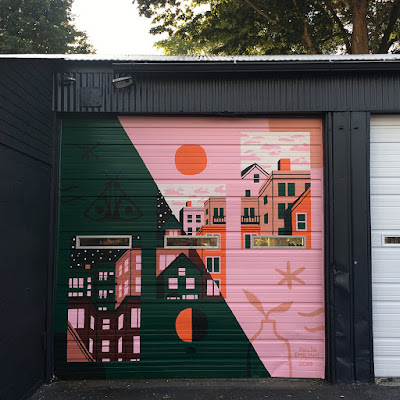 |
| "A Composition of Moments" by Julia Emiliani |
Somerville's Julia Emiliani earned a BFA in Illustration from Massachusetts College of Art and Design.While working full time as an illustrator at Wayfair, Julia also runs an Etsy shop of illustrated goods called Over it Studio. I decided to interview this talented artist,who resides in the "Paris of New England."
Where have you lived before, and how does Somerville compare?
I was born in Florida and raised in Connecticut, I’ve been living in the Boston area for the past nine years. I’ve lived all around Boston and have been in Somerville since 2017. I love how Somerville feels like a small town, but has all the perks of a city. There’s a sense of community and convenience coupled with beautiful neighborhoods and access to nature. Especially in these Covid times, I’ve been thankful for how accessible nature is in the city of Somerville. I’ve recently been drawing a lot of inspiration from it and have been enjoying long winding walks through Somerville’s many neighborhoods.
You have done a lot of commercial art, as well as your own. Can you tell us a bit how you manage both sides of your career?
It’s a tricky balance. My 9-5 takes up most of my time and energy, but I still try to take advantage of my free time to squeeze in personal work. Mornings are huge for me, and while not having an office to go to for my 9-5 can be a roadblock at times, I love having back all of the time I usually spend commuting. It’s when I feel most clear-headed and energetic, so usually use this time to paint before the rest of the world wakes up. I try to carve out peaceful moments like this for myself on evenings and weekends as well, but mornings are especially instrumental in striking a balance between 9-5 work and personal work.
The artist Norman Rockwell was known for his Illustrations in magazines. He was accused by critics of not being a real artist, but simply an illustrator. Have you run into this?
I haven’t personally run into this, but I wouldn’t necessarily echo this idea! To me, art is self expression. Even if commercial art ultimately ladders up to a client, brand, or company’s business goals, the illustrator still has to bring their own thoughts, expression, and sense of self into the final deliverable in order to make it work. Of course a fine artist may have more wiggle room in exploring how they want to express, but the artist is never removed from the process, even for commercial work.
In an article from the Boston Globe, it described your handmade work as “cute and cheeky.” Is this how you would describe it?
I would definitely describe my work in that way at the time that article came out! And I think a lot of the work in my etsy shop (www.etsy.com/shop/OveritStudio) also can be described like this. Currently, the rest of my personal work draws a lot of inspiration from my experiences observing nature with my experience as a commercial artist. I find myself contrasting visual qualities of nature with that of digital art, and more frequently painting using analog materials as a way of slowing down and meditating on a single moment, especially in these hectic times. Now I would describe my work more as bold, graphic, and observational -- or something along those lines.
You developed a line of prints with people riding the MBTA. Tell us a bit about this?
At the time I was spending a lot of my time commuting and drawing on the T, so this series was very reflective of my experiences and surroundings in the Boston area, as well as my personal preferences in color and fashion.
How has the pandemic affected your career?
The pandemic puts everything in perspective. It makes me thankful to still have a day job and makes me think more intentionally about my personal work. It forces me to adjust how to market and sell work in a time where live events like craft fairs and gallery openings, that often bring in engagement and sales, aren’t what they used to be. It also forces me to think more critically about what I’m making and why, relative to these times. Whether it’s making work that brings delight and comfort, protest or activist art, producing work in an environmentally-friendly way, or regularly donating sales to causes that need support. All of these practices are now of higher priority in my work as I adjust to the changing marketplace.
What can we expect to see from you in the near future?
I have a lot of ideas! You’ll definitely see more painting from me, both small and large works. I also have some new printed goods dropping in my Etsy shop Fall/Winter 2020. Beyond that, I’ve been dabbling with different ideas - maybe a line of greeting cards, maybe surface design on fabric, maybe something with ceramics? We’ll see where my explorations take me.
